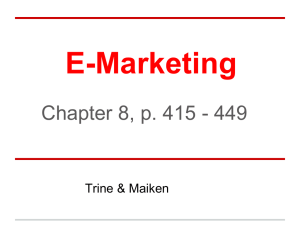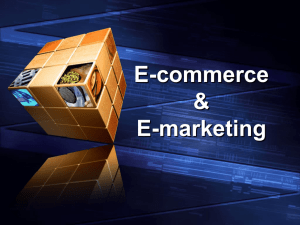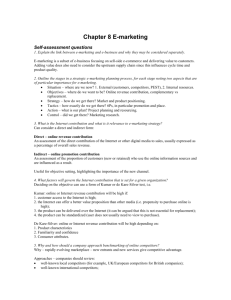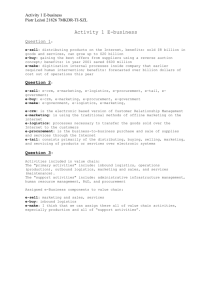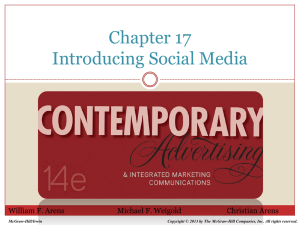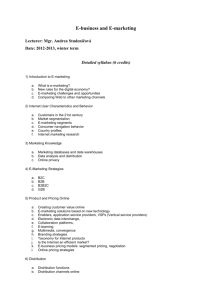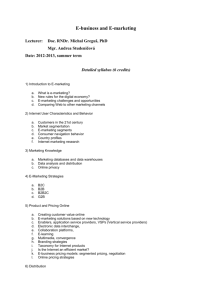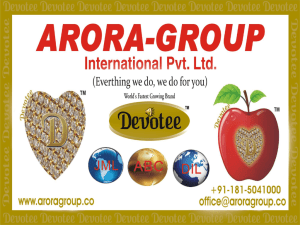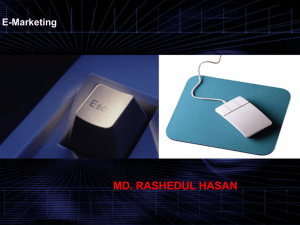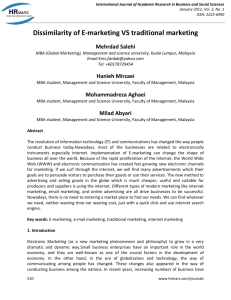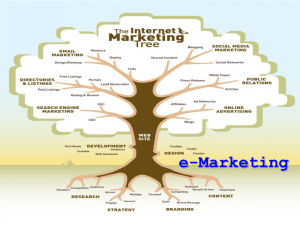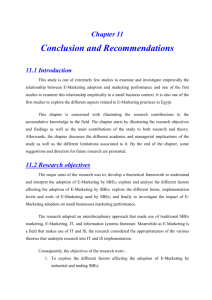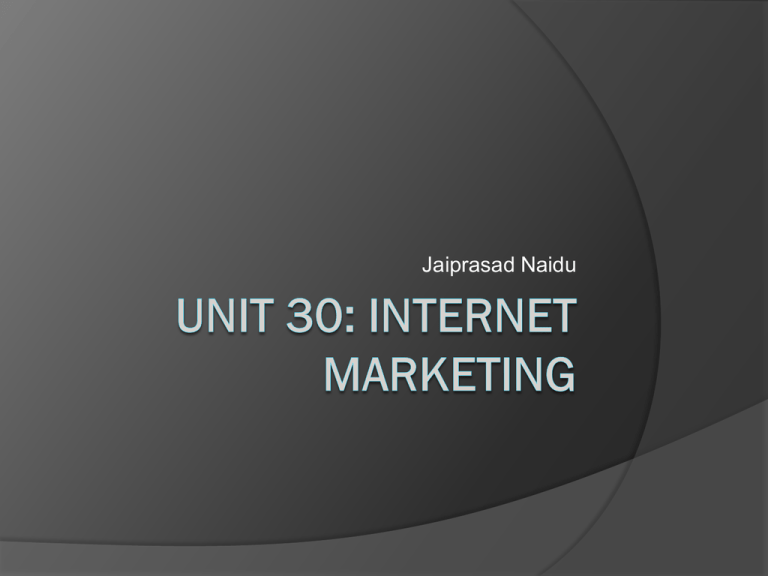
Jaiprasad Naidu
Summary of learning outcomes
To achieve this unit a learner must:
Describe how the internet can be used
for promotion
Explain order processing through the
internet
Explore customer relationships
management through the internet
Examine the use of the internet for
marketing research.
Chapter 1: Introduction
to Internet Marketing
© Prentice Hall 2003
The Google story shows:
Markets
always welcome an
innovative new product providing
customer value.
Customers
trust good brands.
Well-crafted
marketing mix
strategies can be effective in
helping newcomers enter crowded
markets.
Key questions for corporations:
How to use information technology profitably ?
How to understand what technology means for
their business strategies?
How time-tested concepts by marketers can be
enhanced by the Internet, databases, wireless
mobile devices, and other technologies?
What’s next after the rapid growth of the
Internet and the dot-com bubble has marketers
wondering ?
What is E-Marketing?
E-Marketing is the application of a broad range of
information technologies for:
Transforming marketing strategies to create more
customer value (more effective segmentation,
targeting,
differentiation,
and
positioning
strategies)
More efficiently planning and executing the
conception, distribution, promotion and pricing of
goods, services, and ideas
Creating exchanges that satisfy individual
consumer
and
organizational
customers’
objectives.
What is E-Marketing?
Alternative definition:
E-marketing is the result of information technology applied
to traditional marketing.
E-marketing affects traditional marketing in two ways:
○ Increases efficiency in traditional marketing functions
○ The technology of e-marketing transforms many marketing
strategies.
Results: new business models that add customer value
and/or increase company profitability.
What Is E-Business?
E-business “is the continuous optimization of a firm’s
business activities through digital technology”
Digital technologies = information technology are
things like computers and the Internet, that allow the
storage and transmission of data in digital formats (1’s
and 0’s)
The Big Picture
-
Easy, inexpensive, and quick access to digital information
transforms:
economies,
- societies,
governments,
- businesses.
Digital information enhances economies through:
more efficient markets
more jobs
information access
communication
globalization
Uneven impact of the Internet across the globe:
530 million users connected to the Internet worldwide = 8.5%
of the global population,
Developed nations = 15% of the world’s population
= 88% of all Internet users,
U.S. Internet users = 182 million
= 64% of the population,
Indigenous peoples in remote locations gaining health, legal,
and other advice, or selling native products using the
Internet.
Important e-business benefits according
to U.S. top executives:
Building better quality customer relationships,
Finding more business partners
development opportunities,
Building better brand visibility.
and
other
Benefit
% Mentioning
Better quality customer relationships
More business development opportunities
Better brand visibility
Efficient supply chain
Reduce (time-to-market)
Increase customer quantity
61
50
50
42
33
25
The Most Important Benefits of E-Business to U.S. Executives
Source: “Key Business and Marketing...” (2002)
E-Marketing in Context: Where does e-marketing fit into this picture?
Visibility
U.S.
Recesssion
Dot-com
peak
Technology Peak of
Trigger
Inflated
Expectation
1990-1996 1999
Equity times
2000
Trough of
Disillusion
2001 2002
Debt Times
E-Business
becomes “just
business”
Slope of
Enlightnment
2003
Plateau of
Profitability
2004 2005 2006
Positive Cash Flow
There is Hope After the Trough of Disillusion
Source: Adapted from Raskino and Andren of Gartner Research (2001)
Internet Properties and
Marketing Implications
Marketers who grasp what Internet technologies can do will be better
poised to capitalize on information technology.
Internet properties:
- Create opportunities beyond those possible with the telephone,
television, postal mail, or other communication media,
- More effective and efficient marketing strategy + tactical
implementation + change the way marketing is conducted.
E.g. The idea of digitizing data (bits not atoms) has transformed media
and software delivery methods + created a new transaction channel.
Internet Properties and
Marketing Implications
Internet technologies have changed
marketing in a number of critical ways:
Power shift from sellers to buyers,
Death of distance,
Time compression,
Knowledge management is key,
Interdisciplinary focus,
Intellectual capital rules.
traditional
E-Business Markets
Once marketers identify appropriate markets, information
technology facilitates relationships before and after the
transaction with:
Prospects,
Partners,
Customers,
Supply chain members.
There are three important markets that both sell and buy to
each other:
Businesses,
Consumers,
Governments.
Initiated by
Business
Initiated by
Consumer
Initiated by
Government
To Business
Business-to-Business
(B2B)
FreeMarkets
www.freemarkets.com
To Consumer
Business-toConsumer (B2C)
CDNow
Www.cdnow.com
Consumer-to-Business
(C2B)
Better Business Bureau
site
www.bbb.org
Government-to-Business
(G2B)
Small Business
Administration site
www.sba.gov
Consumer-toConsumer
(C2C)
eBay
www.ebay.com
Government-toConsumer
(G2C)
California state site
Www.state.ca.us
Exhibit 1 - 1 E-Business Markets
Source: Marian Wood (2001) with minor adaptation (p. 2)
To Government
Business-toGovernment (B2G)
Western Australian
Government Supply
www.ssc.wa.gov.au/
Consumer-toGovernment
(C2G)
GovWorks
www.govworks.com
Government-toGovernment
(G2G)
GovOne Solutions
http://www.govonesol
utions.com/
Business Market
-
It is huge: more businesses are connected to the internet
than consumers.
It is transparent to consumers: it involves proprietary
networks that allow information and database sharing.
E.g. FedEx, the package delivery firm:
- Its customers can schedule a package pick-up using the Web
site,
- Track the package using a PC or handheld PalmPilot,
- Pay the shipping bill online.
Consumer Market
E-marketers must understand consumers in potential
geographic segments:
Iceland and Denmark = 2 of the most wired countries in
the world = 60% Internet penetration,
Consumers in many countries pay by the minute for local
phone access = determine the kind of casual surfing
practiced by Internet users.
Consumer Market
The consumer market is huge and quite active online:
28% of consumers said they have shopped online or plan
to shop online in the next six months,
15% purchased offline as a direct result of online
information,
U.S. consumers are the biggest online shoppers, spending
US$53 billion in 2001, an increase of nearly 20% from
2000.
Revenge of the Consumer
The rebellion started with television channel surfing using the
remote control. Consumers did not seem to appreciate that
commercials pay for broadcast TV programs.
At the start of the 21st century, consumers have control via the
mouse. When television, radio, print media, entertainment, and
shopping all converge seamlessly on a computer-like device,
consumers will truly have information on demand.
Consumers are more demanding and more sophisticated, and
marketers will have to become better at delivering customer
value.
Consumer Needs
What do customers want in the information economy?
Privacy: Customers want marketers to keep their data confidential +
don’t want to be bothered by sales calls at home during dinner,
To safeguard children from objectionable sites,
Want marketers to ask permission before sending commercial e-mail
messages,
Want e-commerce to provide convenience, self-service, speed, good
customer service, personal attention, and value.
Consumer Needs
Fortunately, e-marketing can meet all these needs:
With mass customization individuals can contact firms over the
Internet and receive responses tailored to their needs,
Business can also customize and personalize products and
communications to strengthen long-term relationships with
customers.
E.g. Amazon.com presents personalized Web pages to users
Exhibit 1 - 1 Amazon.com Uses Mass Customization to Personalize Web Pages
Source: www.amazon.com Amazon.com is a registered trademark or trademark of Amazon.com, Inc. in the United
States and/or other countries. © 2000 by Amazon.com. All rights reserved.
Government Market
The U. S. government is the world’s largest buyer, purchasing
over $200 billion in goods and services every year (see
www.isbdcorp.org/gmag).
Add to this the purchasing power of U.S. states, counties,
cities, and other municipal agencies, and this makes for a huge
market.
Small and large businesses usually have an equal chance of
selling to governments + government Web sites announce their
buying needs in advance of the bidding process.
Government Market
Businesses wishing to sell to
challenges unique to this market:
governments
face
Follow rules regarding qualifications, paperwork, etc.,
Must compete to be on the government list of approved
suppliers + compete for specific contracts through a
bidding process,
Have to conform to very particular timely delivery of
quality products at reasonable prices.
What’s Next?
Regardless of the current disillusion with e-business,
many solid successes exist today and exciting new
growth areas will soon emerge.
Seven trends that will help businesses move forward into
e-marketing :
Integrating IT software,
Boom in Web services,
Collaboration software,
Dealing with too much data,
Data security,
Wireless is here to stay,
Growth in portable
computing.
Review Questions
1.Define e-business and e-marketing.
2.As a technology, how does the Internet compare with the
telephone?
3.What are some of the marketing implications of Internet
technologies?
4.What are the three main markets of e-business, and how do
they differ?
5.In the context of e-marketing, what does “revenge of the
consumer” mean?
Discussion Questions
1. As a marketer, do you agree with the U.S. executives who say
“better quality customer relationships” is one of the most important
e-business benefits? Why?
3. Some economists suggest that the increase in e-commerce within
the B2B market will lead to greater competition and more goods
and services becoming commoditiesthat is, solely competing on
price. How do you think this is likely to affect buyers within the
B2B market? How would it affect sellers?
4. What concerns about consumer privacy are raised by the
increased use of wireless computing and handheld devices
outside the home or workplace?
Chapter 1 : The Internet and
the marketing mix
The marketing mix – widely referred to
as the 4 Ps of Product, Price, Place and
Promotion – was originally proposed by
Jerome McCarthy (1960)
The 4 Ps have since been extended to
the 7 Ps, which include three further
elements that better reflect service
delivery: People, Process and Physical.
The elements of the marketing mix
Product
The product element of the marketing mix
refers to characteristics of a product,
service or brand.
Product decisions are informed by market
research where customers’ needs are
assessed and the feedback is used to modify
existing products or develop new products.
There are many alternatives for varying the
product in the online context when a company
is developing its online strategy.
Internet-related product decisions can be
usefully divided into decisions affecting the
core product and the extended product.
Implications of the Internet for the
product aspect
1 options for varying the core product;
2 options for changing the extended
product;
3 conducting research online;
4 velocity of new product development;
5 velocity of new product diffusion.
1 Options for varying the core
product
1 Can I offer additional information or transaction
services to my existing customer base?
[For example, for a bookseller, providing reviews of
customer books, previews of books or selling books
online. For a travel company, providing video tours of
resorts and accommodation.]
2 Can I address the needs of new customer
segments by repackaging my current information
assets or by creating new business propositions
using the Internet?
[For an online bookseller, creating an electronic book
service, or a DVD rental service as has been
achieved by Amazon.]
3 Can I use my ability to attract customers to
generate new sources of revenue such as
advertising or sales of complementary
products?
[Lastminute.com which sells travel-related services
has a significant advertising revenue; it can also
sell non-travel services.]
4 Will my current business be significantly
harmed by other companies providing some
of the value I currently offer?
[Considers the consequences if other companies
use some of the product strategies described
above.]
2 Options for changing the
extended product
When a customer buys a new computer, it
consists not only of the tangible computer,
monitor and cables
But also the information provided by the
computer salesperson, the instruction manual,
the packaging, the warranty and the follow-up
technical service.
These are elements of the extended product.
Internet for varying the extended
product:
These examples of
how the Internet can
be used to vary the
extended product:
endorsements
awards
testimonies
customer lists
customer
comments
product.
warranties
guarantees
money-back offers
customer service
(see people,
process and
physical evidence)
incorporating tools
to help users during
their selection
3 Conducting research online
The Internet provides many options for
learning about products.
It can be used as a relatively low-cost
method of collecting marketing research,
particularly about customer perceptions of
products and services.
But How ?
Online focus group. A moderated focus group can
be conducted to compare customers’ experience of
product use.
Online questionnaire survey. These typically focus
on the site visitors’ experience, but can also include
questions relating to products.
Customer feedback or support forums. Comments
posted to the site or independent sites may give
information on future product innovation.
Web logs. A wealth of marketing research
information is also available from the web site itself,
since every time a user clicks on a link this is
recorded in a transaction log file summarising what
information on the site the customer is interested in.
Suchinformation can be used to indirectly assess
customers’ product preferences.
4 Velocity of new product
development
Internet can also be used to accelerate new
product development since different product
options can be tested online more rapidly as
part of market research.
Companies can use their own panels of
consumers to test opinion more rapidly and
often at lower costs than for traditional market
research
Network effect of the Internet enables
companies to form partnerships more readily to
launch new products.
5 Velocity of new product
diffusion
The implication of the Internet and concomitant
globalization is that to remain competitive,
organizations will have to roll out new products
more rapidly to international markets.
The Tipping Point explains the three simple
principles that underpin the rapid spread of ideas,
products and behaviors through a population’.
1 The law of the few
2 The stickiness factor
3 The power of context
1 The law of the few
This suggests that the spread of any new
product or service is dependent on the initial
adoption by ‘connectors’ who are socially
connected and who encourage adoption
through word-of-mouth and copycat behaviour.
In an online context, these connectors may
use personal blogs, e-mail newsletters and
podcasts to propagate their opinions.
2 The stickiness factor
Typically, this refers to how ‘glued’ we
are to a medium such as a TV channel
or a website,
But in this context it refers to attachment
to the characteristics and attributes of a
product or a brand.
There are key cross-category attributes
which are key drivers for product
success
Cross-category attributes
Excellence: perceived as best of breed
Uniqueness: clear one-of-a-kind differentiation
Aesthetics: perceived aesthetic appeal
Association: generates positive associations
Engagement: fosters emotional involvement
Expressive value: visible sign of user values
Functional value: addresses functional needs
Nostalgic value: evokes sentimental linkages
Personification: has character, personality
Cost: perceived value for money.
3 The power of context
like infectious diseases, products and
behaviours spread far and wide only
when they fit the physical, social and
mental context into which they are
launched.
It can be suggested that products should
be devised and tested to fit their context,
situation or occasion of use.
Activity 1
Assessing options online to vary product using the
Internet
Purpose
To illustrate the options for varying the product element of
the marketing mix online.
Activity
Select one of the sectors below. Use a search engine to find
three competitors with similar product offerings. List ways in
which each has used the Internet to vary its core and
extended product.
Which of the companies do you think makes best use of the
Internet?
Computer manufacturers
Management consultants
Children’s toy sector
Higher education.
Chapter 1 : Promotion
The promotion element of the
marketing mix refers to how
marketing communications are used
to inform customers and other
stakeholders about an organisation and
its products.
Promotion is the element of the
marketing mix that is concerned with
communicating the existence of
products or services to a target market
Burnett (1993) defines it as:
The marketing function concerned with
persuasively communicating to target
audiences the components of the
marketing program in order to facilitate
exchange
Promotional Mix
The main elements of the promotional or
communications mix can be considered
to be (as stated by, for example, Fill
(2000)):
1 advertising;
2 sales promotion;
3 personal selling;
4 public relations;
5 direct marketing.
These are different approaches for looking at
how the Internet can be used to vary the
Promotion element of the mix:
1 Reviewing new ways of applying each of
the elements of the communications mix
2 Assessing how the Internet can be used at
different stages of the buying process;
3 Using promotional tools to assist in
different stages of customer relationship
management from customer acquisition to
retention.
In a web context this includes gaining initial
visitors to the site and gaining repeat visits
through these types of communications
techniques:
Reminders in traditional media campaigns
why a site is worth visiting, such as online
services and unique online offers and
competitions;
Direct e-mail reminders of site proposition
– new offers;
Frequently updated content including
promotional offers or information that
helps your customer do their job or
reminds them to visit.
Investment in site promotion
1 Investment in site promotion
compared to site creation and
maintenance
2 Investment in online promotion
techniques in comparison to offline
promotion.
3 Investment in different online
promotion techniques.
Investment in site promotion
Since there is often a fixed budget for
site creation, maintenance and
promotion,
the e-marketing plan should specify the
budget for each to ensure there is a
sensible balance and the promotion of
the site is not underfunded.
Investment in online promotion
techniques
A balance must be struck between these
techniques.
Typically, offline promotion investment
often exceeds that for online promotion
investment.
For existing companies traditional media
such as print are used to advertise the
sites, while print and TV will also be widely
used by dot-com companies to drive traffic
to their sites.
Investment in different online
promotion techniques
For example, how much should be paid
for banner advertising as against online
PR about online presence, and how
much for search engine registration?
Communications mix for
increasing visitors
The Internet and branding
What constitutes a successful online brand?
Is it an e-commerce site with high levels of
traffic?
Is it a brand with good name recognition?
Is it a profitable brand?
Or is it a site with more modest sales levels,
but one that customers perceive as providing
good service?
Although sites meeting only some of these
criteria are often described as successful
brands, we will see that a successful brand is
dependent on a wide range of factors.
Branding
Branding seems to be a concept that is difficult
to grasp since it is often used in a narrow sense.
Many think of branding only in terms of aspects of
the brand identity such as the name or logo
associated with a company or products, but branding
gurus seem agreed that it is much more than that
A brand is described as an identifiable product or
service augmented in such a way that the buyer or
user perceives relevant unique added values which
match their needs most closely. Furthermore, its
success results from being able to sustain these
added values in the face of competition.
To summarise, a brand is dependent on a customer’s
psychological affinity for a product,and is much more
than physical name or symbol elements of brand
identity.
Brand promises to build successful
online brands
the promise of convenience – making a purchase
experience more convenient than the real-world one,
or that with rivals;
the promise of achievement – to assist consumers in
achieving their goals, for example supporting online
investors in their decision or supporting business
people in their day-to-day work;
the promise of fun and adventure – this is clearly
more relevant for B2C services;
the promise of self-expression and recognition –
provided by personalisation services such as Yahoo!
Geocities where consumers can build their own web
site;
the promise of belonging – provided by online
communities.
Traditional vs online measures of
brand equity
Case Study
Mini Case study 5.1 – Page 255 (Refer
to your text book )


